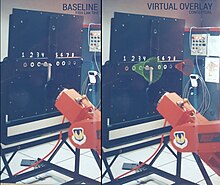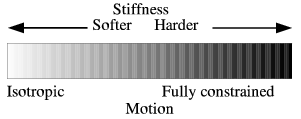
Virtual reality (VR) is a simulated experience that employs pose tracking and 3D near-eye displays to give the user an immersive feel of a virtual world. Applications of virtual reality include entertainment, education and business. Other distinct types of VR-style technology include augmented reality and mixed reality, sometimes referred to as extended reality or XR, although definitions are currently changing due to the nascence of the industry.

Augmented reality (AR) is an interactive experience that combines the real world and computer-generated content. The content can span multiple sensory modalities, including visual, auditory, haptic, somatosensory and olfactory. AR can be defined as a system that incorporates three basic features: a combination of real and virtual worlds, real-time interaction, and accurate 3D registration of virtual and real objects. The overlaid sensory information can be constructive, or destructive. This experience is seamlessly interwoven with the physical world such that it is perceived as an immersive aspect of the real environment. In this way, augmented reality alters one's ongoing perception of a real-world environment, whereas virtual reality completely replaces the user's real-world environment with a simulated one.
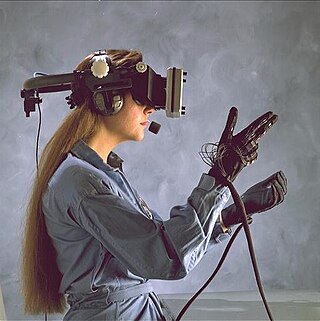
Haptic technology is technology that can create an experience of touch by applying forces, vibrations, or motions to the user. These technologies can be used to create virtual objects in a computer simulation, to control virtual objects, and to enhance remote control of machines and devices (telerobotics). Haptic devices may incorporate tactile sensors that measure forces exerted by the user on the interface. The word haptic, from the Greek: ἁπτικός (haptikos), means "tactile, pertaining to the sense of touch". Simple haptic devices are common in the form of game controllers, joysticks, and steering wheels.
Telepresence refers to a set of technologies which allow a person to feel as if they were present, to give the appearance or effect of being present via telerobotics, at a place other than their true location.

Telerobotics is the area of robotics concerned with the control of semi-autonomous robots from a distance, chiefly using television, wireless networks or tethered connections. It is a combination of two major subfields, which are teleoperation and telepresence.

Computer-mediated reality refers to the ability to add to, subtract information from, or otherwise manipulate one's perception of reality through the use of a wearable computer or hand-held device such as a smartphone.

Mixed reality (MR) is a term used to describe the merging of a real-world environment and a computer-generated one. Physical and virtual objects may co-exist in mixed reality environments and interact in real time.
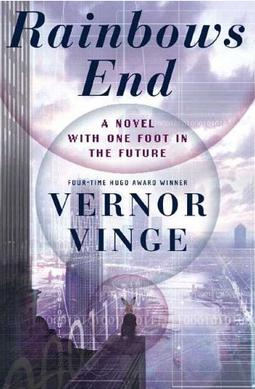
Rainbows End is a 2006 science fiction novel by Vernor Vinge. It was awarded the 2007 Hugo Award for Best Novel. The book is set in San Diego, California, in 2025, in a variation of the fictional world Vinge explored in his 2002 Hugo-winning novella "Fast Times at Fairmont High" and 2004's "Synthetic Serendipity". Vinge has tentative plans for a sequel, picking up some of the loose threads left at the end of the novel. The many technological advances depicted in the novel suggest that the world is undergoing ever-increasing change, following the technological singularity, a recurring subject in Vinge's fiction and nonfiction writing.
Virtual reality in telerehabilitation is a method used first in the training of musculoskeletal patients using asynchronous patient data uploading, and an internet video link. Subsequently, therapists using virtual reality-based telerehabilitation prescribe exercise routines via the web which are then accessed and executed by patients through a web browser. Therapists then monitor the patient's progress via the web and modify the therapy asynchronously without real-time interaction or training.
Characteristic modes (CM) form a set of functions which, under specific boundary conditions, diagonalizes operator relating field and induced sources. Under certain conditions, the set of the CM is unique and complete (at least theoretically) and thereby capable of describing the behavior of a studied object in full.

Immersion into virtual reality (VR) is a perception of being physically present in a non-physical world. The perception is created by surrounding the user of the VR system in images, sound or other stimuli that provide an engrossing total environment.

In radio, multiple-input and multiple-output (MIMO) is a method for multiplying the capacity of a radio link using multiple transmission and receiving antennas to exploit multipath propagation. MIMO has become an essential element of wireless communication standards including IEEE 802.11n, IEEE 802.11ac, HSPA+ (3G), WiMAX, and Long Term Evolution (LTE). More recently, MIMO has been applied to power-line communication for three-wire installations as part of the ITU G.hn standard and of the HomePlug AV2 specification.
A projection augmented model is an element sometimes employed in virtual reality systems. It consists of a physical three-dimensional model onto which a computer image is projected to create a realistic looking object. Importantly, the physical model is the same geometric shape as the object that the PA model depicts.
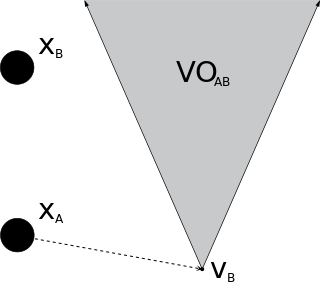
In robotics and motion planning, a velocity obstacle, commonly abbreviated VO, is the set of all velocities of a robot that will result in a collision with another robot at some moment in time, assuming that the other robot maintains its current velocity. If the robot chooses a velocity inside the velocity obstacle then the two robots will eventually collide, if it chooses a velocity outside the velocity obstacle, such a collision is guaranteed not to occur.
Affective haptics is the emerging area of research which focuses on the study and design of devices and systems that can elicit, enhance, or influence the emotional state of a human by means of sense of touch. The research field is originated with the Dzmitry Tsetserukou and Alena Neviarouskaya papers on affective haptics and real-time communication system with rich emotional and haptic channels. Driven by the motivation to enhance social interactivity and emotionally immersive experience of users of real-time messaging, virtual, augmented realities, the idea of reinforcing (intensifying) own feelings and reproducing (simulating) the emotions felt by the partner was proposed. Four basic haptic (tactile) channels governing our emotions can be distinguished:
- physiological changes
- physical stimulation
- social touch
- emotional haptic design.
The TreadPort Active Wind Tunnel is a unique immersive virtual environment that integrates locomotion interfaces with sensory cues such as visual, auditory, olfactory, radiant heat and wind display. The TPAWT augments the Sarcos Treadport consisting of the Cave automatic virtual environment(CAVE) with a subsonic wind tunnel built around the user environment, and adds wind to the virtual environment. The Treadport Active Wind Tunnel is one of the first virtual environments to include wind into the sensory experience of the user. Other systems considering wind display, directly use fans.

In computer vision, pattern recognition, and robotics, point-set registration, also known as point-cloud registration or scan matching, is the process of finding a spatial transformation that aligns two point clouds. The purpose of finding such a transformation includes merging multiple data sets into a globally consistent model, and mapping a new measurement to a known data set to identify features or to estimate its pose. Raw 3D point cloud data are typically obtained from Lidars and RGB-D cameras. 3D point clouds can also be generated from computer vision algorithms such as triangulation, bundle adjustment, and more recently, monocular image depth estimation using deep learning. For 2D point set registration used in image processing and feature-based image registration, a point set may be 2D pixel coordinates obtained by feature extraction from an image, for example corner detection. Point cloud registration has extensive applications in autonomous driving, motion estimation and 3D reconstruction, object detection and pose estimation, robotic manipulation, simultaneous localization and mapping (SLAM), panorama stitching, virtual and augmented reality, and medical imaging.
Visuo-haptic mixed reality (VHMR) is a branch of mixed reality that has the ability of merging visual and tactile perceptions of both virtual and real objects with a collocated approach. The first known system to overlay augmented haptic perceptions on direct views of the real world is the Virtual Fixtures system developed in 1992 at the US Air Force Research Laboratories. Like any emerging technology, the development of the VHMR systems is accompanied by challenges that, in this case, deal with the efforts to enhance the multi-modal human perception with the user-computer interface and interaction devices at the moment available. Visuo-haptic mixed reality (VHMR) consists of adding to a real scene the ability to see and touch virtual objects. It requires the use of see-through display technology for visually mixing real and virtual objects and haptic devices necessary to provide haptic stimuli to the user while interacting with the virtual objects. A VHMR setup allows the user to perceive visual and kinesthetic stimuli in a co-located manner, i.e., the user can see and touch virtual objects at the same spatial location. This setup overcomes the limits of the traditional one, i.e, display and haptic device, because the visuo-haptic co-location of the user's hand and a virtual tool improve the sensory integration of multimodal cues and makes the interaction more natural. But it also comes with technological challenges in order to improve the naturalness of the perceptual experience.

Virtual reality applications are applications that make use of virtual reality (VR), an immersive sensory experience that digitally simulates a virtual environment. Applications have been developed in a variety of domains, such as education, architectural and urban design, digital marketing and activism, engineering and robotics, entertainment, virtual communities, fine arts, healthcare and clinical therapies, heritage and archaeology, occupational safety, social science and psychology.

Louis Barry Rosenberg is an American engineer, researcher, inventor, and entrepreneur. He researches augmented reality, virtual reality, and artificial intelligence. He was the Cotchett Endowed Professor of Educational Technology at the California Polytechnic State University, San Luis Obispo. He founded the Immersion Corporation and Unanimous A.I., and he wrote the screenplay for the 2009 romantic comedy film, Lab Rats.
